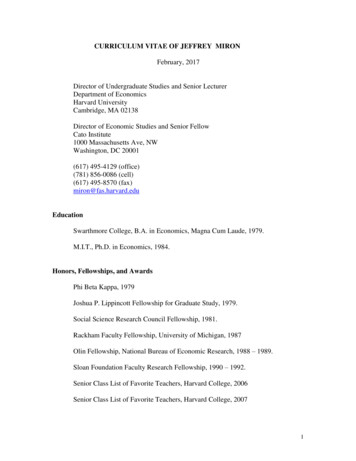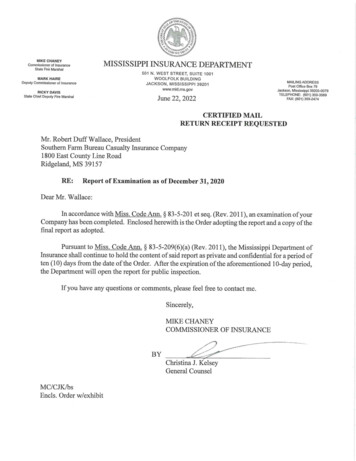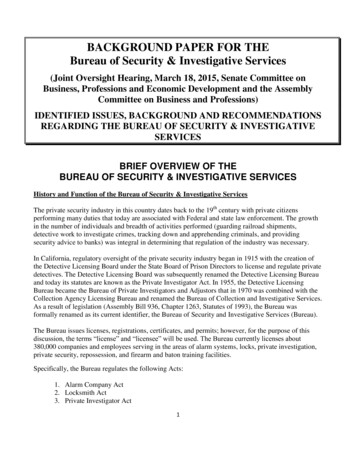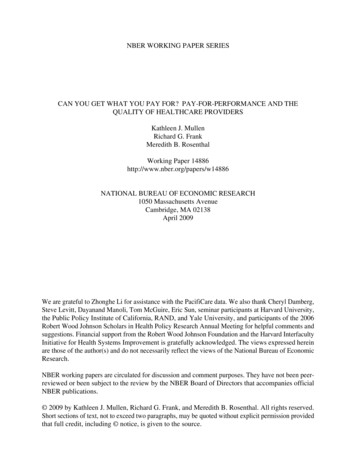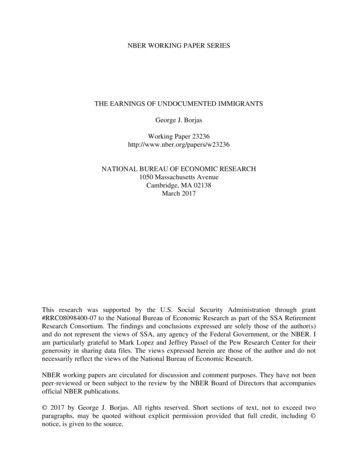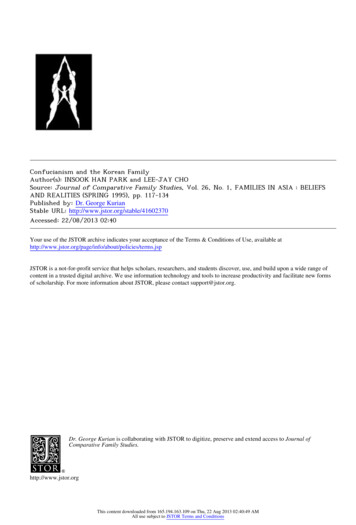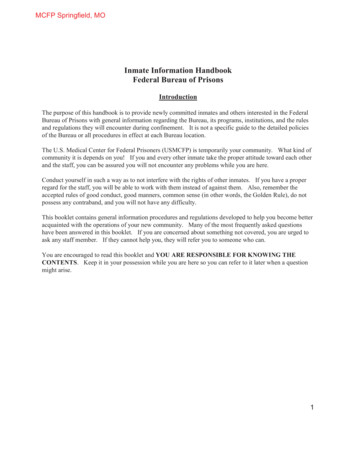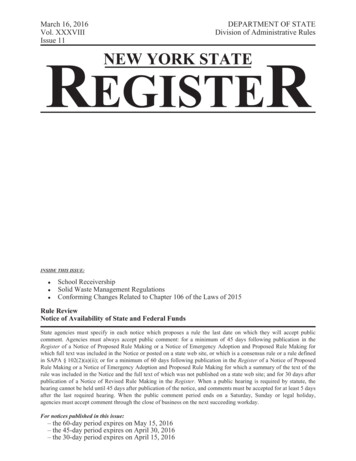
Transcription
NBER WORKING PAPER SERIESCURRENT ACCOUNT SUSTAINABILITY AND RELATIVE RELIABILITYStephanie E. CurcuruCharles P. ThomasFrancis E. WarnockWorking Paper 14295http://www.nber.org/papers/w14295NATIONAL BUREAU OF ECONOMIC RESEARCH1050 Massachusetts AvenueCambridge, MA 02138September 2008This paper, which is forthcoming in the NBER’s International Seminar 2008, is also being releasedas Federal Reserve International Finance Discussion Paper 947. The authors are indebted to Jeff Frankelfor suggesting the topic and to Trevor Reeve for particularly helpful discussions. We thank JamesAlbertus for excellent research assistance and Mike Dooley, Daniel Gros, Philip Lane, Gian MariaMilesi-Ferretti, and participants at the Wisconsin Conference on Current Account Sustainability andthe NBER International Seminar on Macroeconomics Conference in Slovenia for helpful comments.Warnock thanks the Darden School Foundation for generous support. The views in this paper are solelythe responsibility of the authors and should not be interpreted as reflecting the views of the FederalReserve Bank of Dallas, the Board of Governors of the Federal Reserve System, any other personassociated with the Federal Reserve System, or the National Bureau of Economic Research.NBER working papers are circulated for discussion and comment purposes. They have not been peerreviewed or been subject to the review by the NBER Board of Directors that accompanies officialNBER publications. 2008 by Stephanie E. Curcuru, Charles P. Thomas, and Francis E. Warnock. All rights reserved.Short sections of text, not to exceed two paragraphs, may be quoted without explicit permission providedthat full credit, including notice, is given to the source.
Current Account Sustainability and Relative ReliabilityStephanie E. Curcuru, Charles P. Thomas, and Francis E. WarnockNBER Working Paper No. 14295September 2008JEL No. F3ABSTRACTThe sustainability of the large and persistent U.S. current account deficits is one of the biggest issuescurrently being confronted by international macroeconomists. Some very plausible theories suggestthat the substantial global imbalances can continue in a benign manner, other equally plausible theoriespredict a disorderly resolution, and in general it is very difficult to discern between competing theories.To inform the debates, we view competing theories through the perspective of the relative reliabilityof the data the theories rely on. Our analysis of the dark matter theory is cursory; from a relative reliabilityperspective, it fails as it is built on the assumption that an item that is largely unmeasured is the mostaccurate component of the entire set of international accounts. Similarly, the best data currently availablesuggest that U.S. returns differentials are much smaller than implied by the exorbitant privilege theory.Our analysis opens up questions about potential inconsistencies in the international accounts, whichwe address by providing rough estimates of various holes in the accounts.Stephanie E. CurcuruBoard of Governorsof the Federal Reserve System20th Street and Constitution Avenue, NWWashington DC 20551stephanie.e.curcuru@frb.govCharles P. ThomasBoard of Governorsof the Federal Reserve System20th Street and Constitution Avenue, NWWashington DC 20551thomasc@frb.govFrancis E. WarnockDarden Business SchoolUniversity of VirginiaCharlottesville, VA 22906-6550and NBERwarnockf@darden.virginia.edu
1. IntroductionOne of the biggest issues confronting international macroeconomists is whether or not the largeand persistent U.S. current account deficits are sustainable.1 There are varied views about how the currentsituation of global imbalances—in which the United States has a sizeable current account deficit of overfive percent of GDP and, to a first approximation, the rest of the world has a sizeable current accountsurplus—might resolve itself. In a simplistic way these views can be divided into those who believe theseimbalances will evolve in a benign manner and those who worry that their resolution will involvesubstantial disruptions to the global economy, disruptions that could include, among other things, a sharpdecline in the dollar, a sharp increase in U.S. interest rates, and substantial negative spillovers to othereconomies.The problem, from a lay person’s perspective, is that it is extremely difficult to determine whichof the competing views of U.S. current account sustainability are valid. From a distance, they all seemplausible. Take, for example, the “exorbitant privilege” view that the United States can earn its way tocurrent account sustainability because U.S. claims on foreigners earn a much higher rate of return thanforeign claims on the United States. Such a return differential would indeed loosen the U.S. budgetconstraint and make it easier to run continued large current account deficits. As theoretical work such asCavallo and Tille (2006) shows, a positive returns differential would decrease the likelihood of adisorderly adjustment in the U.S. current account and the dollar; were the exorbitant privilege view true,the U.S. current account would be more sustainable than otherwise. Complicating matters is that whilesome—such as Gourinchas and Rey (2007a), Obstfeld and Rogoff (2005), Lane and Milesi-Ferretti(2005), and Meissner and Taylor (2006)—have computed a returns differential that can be described asexorbitant, others (Curcuru, Dvorak, and Warnock 2008a,b; Lane and Milesi-Ferretti 2008) provideevidence suggesting such estimates might be biased upward. Another example is the “dark matter” viewof Hausmann and Sturzenegger (2007), henceforth HS. HS propose an alternative method to computing1On this, see, among others, Hausmann and Sturzenegger (2007), Kitchen (2007), Pavlova and Rigobon (2008),Edwards (2005), Frankel (2006), Roubini and Setser (2004), Obstfeld and Rogoff (2007), and Meredith (2007).
net international positions and current accounts. With their method, global net asset positions are stable,suggesting that the current global imbalances are sustainable and that neither a major adjustment in theexchange value of the dollar nor a large rebalancing of the global economy is necessary. In contrast, Gros(2006) concludes that the U.S. net IIP is more negative than reported after examining the same data. Sowhich is it? Is the actual U.S. net international position more stable than suggested by the published data(the HS view) or more negative (the Gros view)?One way to discern between competing views of current account sustainability is to examine thedata upon which they rely. That is, as we will show in this paper, many competing views on whether theU.S. current account deficit is sustainable or not hinge importantly on beliefs about the relative reliabilityof various components of the international accounts.2Questions about the relative reliability of entries in the international accounts are not new:“Clearly, if our investments abroad are yielding a positive return, theircapital value must be positive not negative. Is this a defect of the figureson current flows, or is it a defect of the balance-sheet figures? The onlyobvious reconciliation is to assign the whole of the statistical discrepancyas an unrecorded negative net investment income, but even that does notseem satisfactory ” (Milton Friedman, 1987)3Over 20 years later, these issues are still open and the question of relative reliability remains a usefulperspective through which to view theories on current account sustainability.Our results can be summarized as follows. First, from a relative reliability perspective the darkmatter view can be quickly dispensed with. HS suggest that the external position for all asset types shouldbe estimated by capitalizing income at a common discount rate. They then compute the net position fromthese capitalized values, and form the current account as the year-to-year change in their constructed netposition. This explicitly assumes that investment income, a subcomponent of the current account, is themost reliable portion of the entire set of international accounts, and that it is appropriate to constructpositions in this manner. Given that approximately two-thirds of published investment income data are2By international accounts we are referring to the balance of payments (BOP) and the international investmentposition (IIP).3Personal correspondence with Charles Thomas, June 1987.2
not measured, but are formed by applying estimates (of yields) to estimates (of positions), from a relativereliability perspective dark matter fails. Moreover, while we have sympathy for some parts of thehypothesis, we find the methodology of capitalizing income streams to be questionable. Even if theinvestment income numbers are entirely reliable, we doubt this method of constructing the currentaccount or position is an improvement over the published estimates.Second, the view that the United States can earn its way to current account sustainability rests onthe continued existence of an exorbitant privilege, which rests in turn on a view of relative reliability inwhich position and flow data form a cohesive dataset. But Curcuru, Dvorak, and Warnock (henceforthCDW) (2008a) argue convincingly that, for the purpose of calculating returns, positions and flows data donot form an internally consistent dataset and show that the returns differential—the difference betweenthe rate that the United States earns on its foreign claims and the rate it pays on its foreign liabilities—isnot as sizable as previously assumed.4To weigh in on this, we first form returns differentials in the most accurate way currentlypossible. For one asset class—direct investment (DI)—we cannot confidently form what we wouldconsider accurate returns, so there we present a range. But with either high or low DI returns, in aggregatewe produce returns differentials that are consistent with those from CDW (2008a) and much smaller thanthe exorbitant privilege view suggests. There is no evidence from carefully constructed returnsdifferentials that the United States can count on earning high international returns.The analysis of returns differentials, as in CDW (2008a) and Lane and Milesi-Ferretti (2008),opens up a puzzle. Specifically, it exposes a substantial “gap” in the international accounts that impliesmismeasurements in some combination of our preferred valuation adjustments, reported balance ofpayments data, and reported international investment positions data. To weigh in on this, we addressknown weaknesses in the accounts by forming adjustments for (i) assets not currently captured in the4CDW’s view can be interpreted as one in which improvements to the data collection system make information onrelatively recent positions (taken from the IIP) more reliable than information on past positions (also in the IIP) andthat position data is generally more reliable than that on financial flows (presented in the IIP, but originating in theBOP) which are seldom revised even after errors are identified.3
historical financial accounts data (residential real estate, which should be in the direct investment data,and financial derivatives, introduced only in 2006), (ii) items that have known shortcomings in thetransactions data in the current and financial accounts but have no known accompanying flaws in thepositions data (IPOs, asset-backed repayments, goods exports), and (iii) items that have knownshortcomings in the positions data but for which the associated transactions data are thought to be sound(short positions, direct investment in intangibles). We develop reasonable plugs to these holes andconstruct revised estimates of the remaining unexplained difference between the cumulated currentaccount deficit and the net IIP.In the end, after accounting for weaknesses in the international accounts, the gap is quite smalland entirely consistent with small CDW-type valuation adjustments. Moreover, our best estimateindicates that the current account deficit is somewhat smaller than has been reported (on average 0.35%of GDP per year), net financial inflows are smaller than reported (on average 0.7% of GDP per year), andthe end-2007 net IIP is 500 billion more negative than reported.In the next section we examine the dark matter hypothesis. In Section 3 we weigh in on theexorbitant privilege view, discuss the relative reliability of various items in the international accounts, andprovide adjustments to plug known holes in the accounts. In Section 4 we take a step back and think morebroadly about current account sustainability, discussing the implications of our results and, just asimportantly, suggesting avenues that are potentially more informative. Section 5 concludes. Drier materialon forming our preferred returns and the details of our adjustments to the international accounts arerelegated to appendices. We provide annual data on our adjustments, as well as some underlying data, athttp://www.nber.org/data-appendix/w14295.2. Dark MatterAt least in its original incarnation, the dark matter of HS rested on a very severe notion of relativereliability. In particular, HS explicitly assume that investment income, a subcomponent of the currentaccount, is the most reliable portion of the entire set of international accounts. Given this view of the4
relative reliability of various components of the international accounts—in this case that information oninvestment income is more reliable than information on the IIP and the current account—a view ofcurrent account sustainability follows. If investment income is the most accurate component of the entireset of accounts, then the HS suggestion that the net IIP should be estimated by capitalizing net investmentincome is reasonable, and so might be estimating net financial flows as the changes in the capitalized-netincome measure of the net IIP.5 Doing so produces global net asset positions that appear to be relativelystable, leading to the HS view that global imbalances are sustainable and that neither a major adjustmentin the exchange value of the dollar nor a large rebalancing of the global economy is necessary.Kozlow (2006) presents a cogent critique of this dark matter hypothesis.6 Here we will raise onlyone point about the leg on which it stands. The notion that income streams are the most accurate aspect ofthe account is patently false. In gross valuation terms, more than two-thirds of the income streams—thosearising from non-DI positions—are derived by taking an estimate of the position, picking a reasonableyield, and applying that yield to positions to estimate income streams. In 2007, combined gross incomepayments and receipts totaled a bit less than 1.5 trillion; of this more than 1 trillion was non-DI andhence was estimated by applying an estimated rate of return to estimated positions.7 Our view is that froma relative reliability perspective this theory, which relies on largely on data constructed by applyingestimates to estimates, is fairly weak.Since HS first applied the term dark matter to international accounting, it has become associatedwith the difficulty in accounting for cross-border transactions in intellectual property (IP) such as patents,trademarks, and other intangibles. We have some sympathy for this view. In the U.S. National Incomeand Product Accounts (NIPA) all trade in IP (whether for the use of the IP or ownership rights to it) is5HS actually suggest that the current account balance, not net financial flows, be measured in this way. However,estimating the current account in this way ignores the potentially large (if currently unmeasured) contribution ofcapital account transactions and introduces inconsistencies into the NIPA measurement of product.6See also Willem Buiter’s critique, “Dark Matter or Cold Fusion?” (http://www.nber.org/ wbuiter/dark.pdf).7Thus, when positions data are revised when more accurate information becomes available, so too are incomestreams. This explains why starting in the late 1990s the United States repeatedly became a net debtor in the incomebalance only to have revisions to positions push it back into the black.5
included in the current account under services.8 This is true for trade between unaffiliated parties as wellas trade within a DI relationship. BEA has recognized that its coverage of these transactions has beenincomplete and recently revised its forms and reporting panels.9 Although these efforts will likelyincrease coverage, and perhaps increase recorded services trade, they will likely do little to address theissue of how firms value the IP transferred between affiliates. One hypothesis to reconcile the highincome rate of return earned on U.S. direct investment abroad and the low income rate of return earned onforeign direct investment in the United States is that U.S. firms undervalue the IP transferred to theirforeign affiliates while foreign parents overvalue the IP transferred to their U.S. affiliates.We are not going to address this issue beyond making two points: First, the current cost valuationof DI used throughout this paper excludes intangibles, including IP. Second, the fundamental issuesassociated with sustainability depend on the willingness of cross-border investors to continue investingand the servicing burden of the investment positions. The particular values that compilers attach to DIpositions in the IIP are irrelevant. For example, foreign parents may be quite happy with the fact that theirU.S. affiliates earn low (profit) rates of return so long as they pay large royalty payments back to theparent. From the standpoint of the current account (and hence financial flows), it does not matter if thedebit entry is recorded as investment income payments or royalty payments.108This treatment is out of sync with the System of National Accounts, 1993, (SNA93) and causes an inconsistency inthe NIPA measurement of product. Within SNA93, transactions in the ownership rights to IP are to be recorded inthe capital account unless the IP is the result of research and development (R&D). Trade in the ownership rights toIP that results from R&D is to be recorded in the current account as “research and development services.” However,trade in the rights to use IP are to be recorded in the current account under services as “royalties,” regardless ofwhether R&D was an input to the IP. In the draft edition of the update to the Balance of Payments Manuel, BPM6,the term “royalties” has been replaced by “Fees for franchises and other property rights.”9The new form, BE-125, first collected data for 2006. Estimates based on these data will be folded into the annualrevisions to the IT accounts published in June 2008.10We can be more precise on this point. Consider, for example, a foreign subsidiary (the sub) that does not payroyalties to its U.S. parent and instead books a high profit and pays taxes to its host country, which, in a host countrylike Ireland, would be at a low rate. The U.S. parent pays no taxes until the sub repatriates the income; if the subdoes pay royalties to its parent, the sub's profits are lower and the sub pays (a little) lower taxes to its host country.In that case the U.S. parent has the higher royalty income which, all else equal, flows directly into pre-tax profits;U.S. tax must now be paid on this, presumably at a higher rate than in the host country. As long as the sub hassomething reasonable to do with the funds abroad, then it makes sense to not pay royalties. If and when there comesa time when the parent needs the funds back home, the sub pays the parent a dividend and at that time the parentpays taxes to the U.S. government equal to the difference between what it would normally pay and what the sub hasalready paid to the sub's host country. Note that the accounting treatment of these earnings may, however, violate6
3. Exorbitant PrivilegeThe exorbitant privilege view that the United States might be able to earn its way to currentaccount sustainability also hinges on relative reliability. Proponents of this view point to the large returnsdifferential the United States enjoys—the idea that the United States can persistently earn sizably more onits foreign portfolio than it pays foreigners on their U.S. portfolios—that has been reported in Gourinchasand Rey (2007a), Obstfeld and Rogoff (2005), Lane and Milesi-Ferretti (2005), and Meissner and Taylor(2006). Subsequent work—CDW (2008a,b) and Lane and Milesi-Ferretti (2008)—has found that earlyestimates of the U.S. returns differentials were biased upward.Why is there a discrepancy between estimates of the returns differential? From a relativereliability perspective, the large U.S. returns differential and, hence, the empirical cornerstone of theexorbitant privilege view, rests on the implicit but ultimately incorrect assumption that the variouscomponents of the U.S. international accounts form a cohesive dataset (CDW 2008a). The CDW view canbe interpreted as one in which information on relatively recent positions (taken from the IIP) is morereliable than information on past positions (also in the IIP) and financial flows (presented in the IIP, butoriginating in the BOP).In this section we put forward what we believe to be the best quality information on returnsdifferentials currently available. Our analysis exposes a substantial gap in the international accounts—aninconsistency between our preferred valuation adjustments, reported balance of payments data, andreported international investment positions data—that we then address. We end by summarizing theimplications of our analysis for the exorbitant privilege view. Data availability limits our analysis to theperiod from 1990 to 2007.IRS transfer-pricing guidelines and can result in significant tax penalties such as those recently levied onpharmaceutical companies Merck & Company and Glaxo SmithKline. See “Merck Tax Settlement Carries 2.3BTab”, WebCPA, Feb. 15, 2007, available at http://www.webcpa.com/article.cfm?articleid 23366.7
3.1 Estimating Returns DifferentialsReturns on international investment positions are never directly measured and thus must beinferred from other data. As shown in CDW (2008a), there are essentially three methods for estimatingcross-border returns. Two methods use IIP data—one as-reported data from each year’s IIP release, theother the current vintage of revised data—on flows and positions to back out implied returns. The thirduses a combination of market-based returns data where possible and original IIP data where market-baseddata are not readily available. In this section we discuss and compare the three methods.3.1.1 Original IIP MethodThe “Original IIP” approach estimates capital gain returns for a particular asset class using:rtO AtO AtO 1 FLOWt O OAtO1AtO 1 FLOWt O2(1)where A, FLOW, and OA denote positions, flows, and “other adjustments” and the O superscript denotesthat all are as reported in the original year t IIP release.11From a relative reliability perspective, the Original IIP method presumes that originally reportedpositions and flows form a cohesive dataset and that originally reported “other adjustments” are notvaluation adjustments. These “other adjustments” are one item in the IIP presentation: In each annual IIPrelease, for both claims and liabilities positions and for each asset class, BEA provides a reconciliationbetween start- and end-of-the-year positions, attributing movements over the year to net flows, valuationchanges due to price or exchange-rate movements, and “other adjustments.” BEA defines “otheradjustments” as (i) changes in coverage, (ii) capital gains and losses of direct investment affiliates, and(iii) other adjustments to the value of assets and liabilities. Large contributors to “other adjustments” are11Throughout, DI is valued using the current-cost method. Alternatively, these positions could be reported based ontheir historical cost, or based on an estimate of the current market value. BEA shifted their emphasis to the currentcost method starting in 2006. In general, the value of DI is extremely difficult to determine because it typicallyinvolves illiquid ownership interest.8
the addition of new reporters to the panels, identified reporting errors, and reclassification of assetsamong categories, but—except for the banking and nonbanking categories—the “other adjustments”reported in the original IIP releases are very minor.Column (A) of Table 1 shows capital gains returns differentials computed using the Original IIPmethod. The overall differential is quite small at 0.7 percent per year for the period from 1990 to 2007.The source of this modest differential is the different compositions of U.S. assets and liabilities, firstpointed out by Gourinchas and Rey (2007a); U.S. assets are weighted toward equities and DI, while U.S.liabilities are weighted toward lower yielding debt securities.3.1.2 Revised IIP MethodThe second method, the “Revised IIP” method, uses the following formula to calculate impliedcapital gains returns:AtR AtR 1 FLOWt Rrt 1AtR 1 FLOWt R2R(2)where the R superscript denotes that these variables are formed using the most recently revised data (thatis, the current vintage of revised data).12Note that an implicit assumption behind (2) is that the current vintage of revised positions andflows data form a consistent data set from which implied returns can be computed. While one wouldexpect revisions to generally enhance the accuracy of reported data, when computing implied returnsfrom position and flow data it is relative reliability that matters. In fact, Figure 1, reproduced from CDW(2008a), shows that over time positions data have been systematically revised upward from a U.S.perspective,13 while flows are little revised. Large upward revisions to positions with essentially no12Equations (1) and (2) differ slightly from those presented CDW (2008a) because the denominator includes a termfor one-half of the year’s flows, and the numerator in equation (1) also subtracts the contribution of “otheradjustments.” The differences in the resulting valuation adjustments are minor.13This upward revision in U.S. positions is a combination of upward revisions to U.S. assets abroad and downwardrevisions to foreigners’ positions in the United States.9
corresponding revisions to flows produce—when returns are computed using (2)—large returnsdifferentials.14 This is evident in Column (B) of Table 1: In aggregate the Revised IIP method produces asubstantial capital gains returns differential of 2.4 percent per year, owing to large differentials favoringthe United States for bonds, equities, and direct investment.3.1.3 Our Preferred MethodOur preferred method takes the following approach. For portfolio bonds and equities, as in CDW(2008a,b) we use a market-based approach that assumes that holdings data are the most accurate aspect ofthe international accounts and applies reasonable returns indices to the measured positions to formestimated returns. For asset classes where capital gains are minor and little additional informationbecomes available over time, such as the banking/nonbanking/other categories, we assume the OriginalIIP releases provide a reasonably accurate picture. The most difficult asset class for which to estimatereturns differentials is direct investment. There is a long literature on puzzling aspects of returns on directinvestment in the United States and abroad.15 From our perspective, the difficulty in calculating accuratereturns differentials for DI stems from three factors: (i) BEA only publishes revised valuation and otheradjustments for aggregate claims and liabilities, without a breakdown by asset class, so there is noreported estimate of adjustments in revised data, (ii) there are no market-based indices that areappropriate, and (iii) in contrast to other asset classes, “other adjustments” in the current vintage ofrevised data likely contains some information on valuation adjustments. To address the first factor, weinfer DI other adjustments as what remains after we subtract the “other adjustments” associated with nonDI assets from the reported aggregate. With regard to the last two factors, we calculate implied DI returnsfrom the current vintage of data by assuming that either all revised DI “other adjustments” are indeedvaluation adjustments or, alternatively, that they are associated with intangibles and should remain “other14To be more precise, this statement is true only if previous-period positions are not fully revised. They are not; seeCDW (2008a).15There is a long-standing, positive total returns differential for direct investment, the bulk of which arises fromrelatively higher income yields. The capital gains differential reported in Table 1 ranges from 0.8 to 2.3 percent peryear, depending on how other adjustments are treated.10
adjustments”. This approach means that we have a range of returns for DI, which, while not entirelysatisfactory, at least accurately depicts our lack of knowledge of underlying DI returns.16Complete details of the calculations behind our preferred method—from our choices of returnsindices to the way we estimate DI other adjustments—are provided in Appendix A. The resulting returnsare in Column (C) of Table 1. Returns differentials computed using our preferred method are quite small,with an aggregate differential of 0.9-1.1 percent per year, depending on whether DI “other adjustments”are considered valuation adjustments.3.1.4 Comparison of the Three MethodsThe aggregate differential from our preferred method is only slightly higher than that from theOriginal IIP method, but much smaller than the differential from revised data. The asset classes thatproduce the large discrepancy between our preferred returns and those from the Revised IIP method areequities and bonds. Our preferred capital gains rates on equity claims are significantly smaller than thosecomputed by the Revised IIP
of the Federal Reserve System 20th Street and Constitution Avenue, NW Washington DC 20551 stephanie.e.curcuru@frb.gov Charles P. Thomas Board of Governors of the Federal Reserve System 20th Street and Constitution Avenue, NW Washington DC 20551 thomasc@frb.gov Francis E. Warnock Darden Business School University of Virginia Charlottesville, VA .
